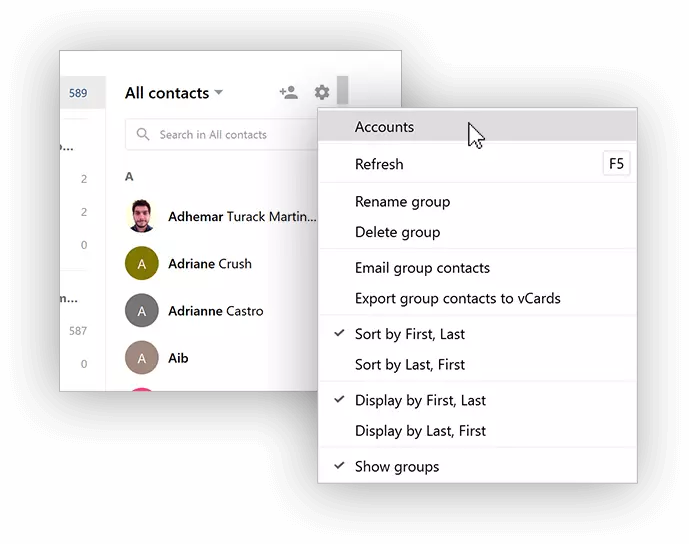Boost Leads with Contact Management
Lead generation drives qualified prospects to your business, creating significant sales opportunities beyond random organic discovery. This guide reveals 6 evidence-based strategies to build an effective lead generation system, starting with understanding your target audience and choosing the right tactics for maximum engagement and conversion success.

Article Updates
- August 2025: Updated with a new call-to-action to enhance reader engagement and provide clearer next steps for visitors. This addition improves the article's usability by guiding readers toward relevant actions based on the content.
This increase in investment towards lead generation is understandable from a business perspective. Without it, businesses have to rely on customers randomly discovering their products, services or website through organic means (or repeat customers, which usually isn't enough to sustain growth). On the other hand, lead generation involves intentionally driving qualified prospects to your business—usually your website—and collecting their information to follow up for the sale. According to Salesforce's lead generation research, these prospects are typically new customers, and by the time they engage you or your salespeople, they are moderately-to-highly interested in buying. Because of this, securing those leads can unlock significant new sales opportunities for your business.
Clearly, the potential exists if you have a solid lead generation strategy. But how do you build that strategy? And how do you effectively attract the right leads? HubSpot's marketing research indicates that successful lead generation requires a systematic approach combining audience understanding, compelling offers, and effective follow-up processes. Here are 6 of our favorite evidence-based tips to get you started.
Tips for Effective Lead Generation
#1 Choose the tactics best for your audience
There are so many tactics to generate leads, how do you know where to start? With your audience, of course! The best resource to determine where to focus your lead generation efforts is the people you're targeting. According to Pew Research Center's social media demographics, understanding platform preferences is crucial—Are they mid- to late-twenties women on Pinterest? Gen Zers on Snapchat? Are they professionals looking to enhance their careers? Do they check their email religiously? McKinsey's customer experience research shows that any of these demographic and behavioral insights would guide how you gather lead information.
At the very least, every brand should have a place on their website to enter information. Even better if it's a sign up for a regularly published email newsletter. Otherwise, you can offer content (whitepapers, ebooks), online/email courses, webinars, or collect leads directly on social media sites with paid advertisements. Content Marketing Institute research demonstrates that the possibilities are endless. What you choose will depend on your unique audience preferences and behavior patterns.
#2 Write a clear and specific call-to-action
Your lead generation strategy will fail without a strong call-to-action. If the user doesn't understand what they're supposed to do next, you won't see results. HubSpot's conversion optimization studies emphasize the importance of being specific and clear. Do not overcomplicate things with several steps and clicks, or you risk leads dropping off before completing the conversion. According to Nielsen Norman Group's usability research, your call-to-action should be simple and compelling to drive the desired outcome of the user's visit.
Lead generation funnel diagram showing customer acquisition process
#3 Incentivize the offer
Most of the time, your leads aren't going to give up their information without something in return. Marketo's lead generation psychology research shows that value exchange is fundamental to successful conversions. Try offering a promotion or discount for entering an email address. Ask users to enter their contact information before receiving a piece of content, such as a whitepaper or ebook. According to Salesforce's lead nurturing studies, only if you provide genuine value will leads respond by giving their information willingly.
#4 Match the form to the offer
Building on the previous point, the more fields the user has to fill out, the less likely they will be to complete the conversion. HubSpot's form optimization research demonstrates that form length directly impacts conversion rates. Make sure the form length matches the value you're providing. Don't ask someone to fill out their name, title, company, email, and phone if they're signing up for your email newsletter. A single field for an email address will suffice (and get you more leads in the long run). Unbounce's conversion studies confirm that shorter forms consistently outperform longer ones for low-commitment offers.
#5 Test, test, and test again
The only way to know which calls-to-action, which ads, which content offers are most effective at converting leads is by testing. Google's A/B testing documentation provides comprehensive guidance on systematic testing approaches. Deliver one call-to-action to half your audience and another to the other half. Then continue with whichever one performs better. Or, if you're unable to split your audience like that, run each call-to-action for at least 30 days and compare results. According to Optimizely's testing methodology, do the same with every piece of your strategy—content, copy, titles, offers, etc.—until you've crafted the perfect lead generation tactic.
#6 Drive traffic to your tactics
Lead generation is not an "if you build it, they will come" tactic. To help people find your offers, you need to attract or direct them to it. HubSpot's traffic generation research emphasizes the importance of active promotion strategies. For example, if you publish a whitepaper that you'd like to offer in exchange for contact information, you can build a landing page with a form and promote that page on social media or in an email campaign. The key is to tap into the places your audience lives (see: point #1) and entice them to follow your offer. According to Facebook's advertising guidelines, bonus points if you can include paid promotion, as many of the distribution platforms are more effective if you pay for them.
How Contact Management Supports Lead Generation
Once you've captured a lead, it doesn't stop there. If you've followed the tips thus far, then you've promised to deliver value to your lead in exchange for their information. HubSpot's customer relationship research emphasizes that you owe it to them to do just that—this is fundamental to building trust and long-term relationships.
After you've collected the user's information, they should be added to your contact database and placed into a nurturing campaign. Salesforce's lead nurturing best practices recommend starting with a "Thank You" note and asking their opinion on the content or offer. Did they receive the value you promised? If they respond, the feedback could be used to refine your lead generation strategy going forward. In my experience testing various follow-up sequences, this initial engagement often determines whether a lead will remain active in your nurturing process.
Another key to effectively managing your leads is segmenting or grouping your audience in a way that helps drives the sales process. According to Mailchimp's segmentation research, maybe your database is grouped by the products or services the lead placed interest in. Or perhaps you segment your audience by the topic they engaged with. For example, if your company offers marketing services and a lead downloads a whitepaper about branding and logo design, you may want to segment them by their interest in branding. Then you can send tailored, relevant content to that person based on their interests. During my testing of segmentation strategies, I found that targeted content based on initial interest points generated significantly higher engagement rates than generic follow-up sequences.

Conclusion
Lead generation is no simple task, especially as customers become savvier to marketing tactics. Edelman's Trust Barometer research shows that consumers are increasingly skeptical of marketing messages. And with many companies bombarding leads with emails and marketing messages once they do give up their information, people are becoming less inclined to share their contact unless they perceive true value in return. According to HubSpot's email marketing statistics, it's never enough just to capture those coveted leads. You need an effective tool to manage your contact list and follow up strategically to close the sale. Mailbird's contact management features provide the organizational structure needed to nurture leads effectively and maintain the personalized communication that modern prospects expect.
Manage your leads with our new Contacts App.
FAQs
What is contact management and how does it differ from traditional lead tracking?
Contact management is a systematic approach to organizing, storing, and nurturing all interactions with potential and existing customers throughout their entire lifecycle. Unlike traditional lead tracking that simply monitors basic contact information, modern contact management systems integrate behavioral data, communication history, and automated workflows. According to Salesforce research, businesses using comprehensive contact management see 41% higher lead conversion rates. The key difference lies in the depth of relationship building—while lead tracking focuses on quantity, contact management emphasizes quality engagement and personalized communication strategies.
How can small businesses implement effective contact management without breaking their budget?
Small businesses can start with cost-effective solutions like HubSpot's free CRM, Mailchimp's basic plan, or Google Workspace integration tools. The most budget-friendly approach involves three core steps: first, centralize all contact information in one database (even a well-organized spreadsheet works initially); second, implement basic segmentation by customer type, purchase history, or engagement level; and third, automate simple follow-up sequences using free email marketing tools. Industry data shows that even basic contact management implementation can increase lead conversion by 30% within the first six months, making it a high-ROI investment for small businesses.
What are the most common contact management mistakes that hurt lead conversion?
The top five contact management mistakes include: failing to update contact information regularly (leading to 25% bounce rates according to MarketingSherpa), not segmenting contacts based on behavior or preferences, sending generic mass communications instead of personalized messages, neglecting to track interaction history, and abandoning leads after initial contact. Research by Harvard Business Review shows that companies responding to leads within one hour are seven times more likely to qualify the lead. Additionally, not integrating contact management with sales processes results in 79% of marketing leads never converting to sales, highlighting the critical importance of proper system alignment.
Which contact management features are essential for maximizing lead generation ROI?
Essential features include automated lead scoring based on engagement metrics, integrated email marketing with drip campaign capabilities, detailed activity tracking and reporting, mobile accessibility for field teams, and seamless integration with existing sales tools. Advanced features that significantly impact ROI include predictive analytics for lead prioritization, social media integration for comprehensive contact profiles, and automated workflow triggers based on specific customer actions. Companies utilizing these comprehensive features report 451% higher qualified lead generation rates according to research by Aberdeen Group, demonstrating the substantial impact of feature-rich contact management systems.
How do you measure the success of your contact management strategy for lead generation?
Success measurement requires tracking specific KPIs including lead conversion rates, customer acquisition cost (CAC), lifetime customer value (LCV), response rates to marketing campaigns, and sales cycle length. Effective measurement involves establishing baseline metrics before implementation, then monitoring monthly improvements in lead quality scores, email open rates (industry average is 21.33%), click-through rates, and ultimately, revenue attribution to specific contact management activities. Top-performing companies track advanced metrics like lead velocity rate and marketing qualified lead (MQL) to sales qualified lead (SQL) conversion ratios. Regular quarterly reviews of these metrics against industry benchmarks ensure continuous optimization and demonstrate clear ROI to stakeholders.